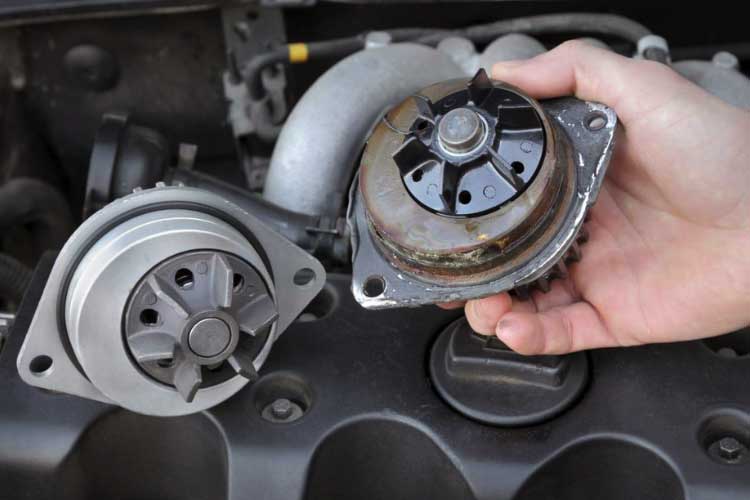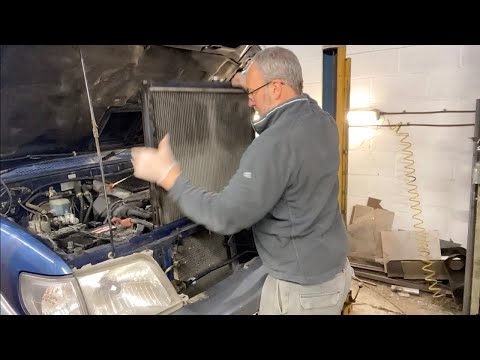Car maintenance can be a difficult business, and when anything goes wrong, it can be both frustrating and costly. Car overheating after installing a new water pump is a regular problem for car owners.
So, why is your car overheating after a new water pump installing? The most common causes include incorrect installation of the water pump and malfunctioning thermostat. Also, a clogged radiator or a leaking head gasket can cause this.
In this post, we’ll go deeper into these causes and suggest some solutions to assist you in resolving the issue. We’ll also look at some precautionary actions you may need to take to avoid this problem in the future.
Car Overheating After new Water pump: Causes, Fixes and Precautions

Car overheating may be unpleasant, especially after a new water pump has been fitted. Now, we’ll look at the most prevalent reasons for this problem and offer strategies to repair it. Let’s get started!
1. A Clogged Radiator or A Leaking Head Gasket

There are several reasons why a car overheats for a clogged radiator or a leaking head gasket.
- Overheating can occur when a radiator becomes blocked, preventing coolant from flowing through the system.
- A buildup of dirt, corrosion, or mineral deposits can produce a blocked radiator.
- If the radiator becomes blocked, it will be unable to properly transmit heat away from the engine, causing the coolant temperature to increase.
- A failing head gasket can cause coolant to escape from the system, causing overheating. It can also prevent coolant from properly circulating and the engine from adequately removing heat.
- The engine may lose compression and power as a result of a leaky head gasket, making it challenging to drive.
- Other symptoms of a leaky head gasket include low coolant level, low compression, coolant in the oil, oil in the coolant, and white smoke from the exhaust.
Take into account that these are the most prevalent instances that are commonly observed. You may have also observed some additional symptoms. It’s merely a standard analysis.

Potential Fixes and Precautions
The possible fixes for a clogged radiator are flushing, cleaning, and replacing. Flushing the radiator involves removing the coolant and flushing it with water to remove debris, rust, or mineral deposits. Cleaning the radiator can be done using a radiator brush or specialized cleaning solution.
Replacing the radiator if it’s severely clogged or damaged is also a good idea. It’s important to have a professional mechanic perform the replacement to ensure the new radiator is installed correctly and that the car is safe to drive.
You may watch this video to have a better understanding of fixing a clogged radiator:
2. Improper Water Pump Installation
A damaged water pump system can create a variety of issues, including overheating. One of the most serious problems is that it might create leaks in the water pump or the hoses that connect to it.
These leaks can decrease the quantity of coolant flowing through the system, causing the engine to overheat. Furthermore, if the water pump is not correctly tightened, it may not be able to provide the necessary pressure to circulate the coolant, which can lead to overheating adequately.
Another issue is that a misaligned water pump can cause the bearing inside it to wear out quickly. Thus, this can cause the water pump to stop working or work less effectively, leading to overheating.

Potential Fixes and Precautions
Some of the possible fixes are given below. But it is always good to have an expert checking into your car’s error.
- Reinstall the water pump, making sure it is properly aligned and securely attached to the engine block.
- Check and tighten all bolts and connections to ensure there are no leaks.
- Replace any gaskets or seals that are damaged or worn out.
- Check the belt tension and adjust it if necessary.
- Look for damage to the impeller and replace it if needed.
- Verify the pump’s rotation direction is correct.
- Check for proper coolant flow and level in the system.
- Check the electrical connections and wiring for the water pump, and repair or replace them as needed.
- Inspect the water pump’s bearings, and replace them if they are worn or damaged.
- Have a professional mechanic check the system to ensure proper installation and operation of the water pump.
If anything needs to be fixed or replaced, it is always wise to consult with a technician. It may charge you some money, but it could save you from further inconveniences.

3. Malfunctioning Thermostat
A malfunctioning thermostat is a frequent cause of automobile overheating, especially after installing a new water pump. The thermostat is a temperature-controlled valve that controls coolant flow through the engine and radiator.
It is commonly found in the engine block or cylinder head and regulates coolant flow by opening and shutting dependent on engine temperature.
A Faulty thermostat can lead to overheating as it can’t regulate the flow of coolant through the engine and radiator effectively. This can happen if the thermostat is stuck in a closed position, which blocks the flow of coolant.
Thus, this also can happen if it’s stuck in an open position, causing the coolant to flow too much and making the engine too cool.

Potential Fixes and Precautions
In that case, replacing may be the best option. However, you should double-check what happens to your car. It could be useful.
Potential fixes are given below.
- Change the thermostat.
- Inspect the thermostat housing and, if required, clean it.
- The coolant level should be checked and if applicable, topped off.
- Assess the coolant flow and the hoses, radiator, and water pump.
- Replace the temperature sensor if required.
- Check the system with a skilled mechanic.
Keep in mind these things are estimated. It may not work in your automobile. Hence, it is always wise to be aware of your automobile and its drawbacks, especially in this era of technology.
4. Other Potential Causes and Fixes
The air might become caught in the different hoses and passageways when coolant is supplied to the system. This can obstruct coolant flow via the engine and radiator, resulting in overheating.
To resolve this issue, you must bleed the cooling system. This may be accomplished by opening the bleeder valves on the engine and radiator and driving the vehicle until the air bubbles are purged from the system.

FAQs
If you still have some questions, have a look at this section. We will answer some of the most asked questions here.
Yes, a water pump that is too small for your vehicle might cause it to overheat. The water pump is in charge of moving coolant through the engine and radiator.
Yes, a lack of sufficient water pump lubrication can cause a car to overheat. If the coolant is not properly cycled through the water pump, the water pump’s bearings may not be adequately lubricated.
Yes, it can cause overheating. If a water pump is not designed for a specific make and model of a car, it may not fit correctly.
Conclusion
Lastly, automobile overheating after installing a new water pump might be caused by a variety of circumstances. These include a faulty water pump, a clogged radiator, and a failed head gasket. Each of these issues can lead to reduced coolant flow and increased engine temperature.
Therefore, correctly identifying the underlying issue is crucial, as is taking the necessary steps. This may include flushing, cleaning, and replacing the radiator, as well as head gasket repair, engine block repair, and engine replacement. Regular maintenance and check-ups are necessary in this case.

